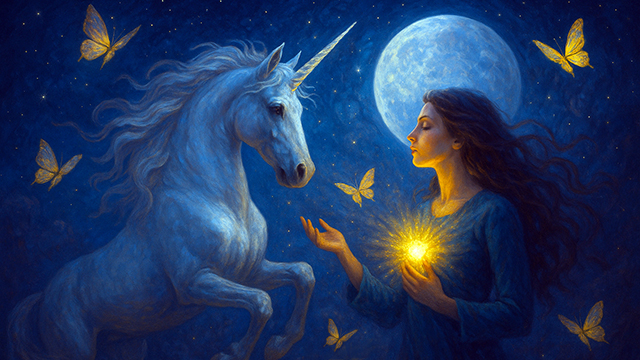01 Jul Soulfulness – The Hidden Architecture of Innovation

The Soul’s Role in Creative Leadership and Transformational Change
The Creative Moment Series | Article 6 | Nourishment from The Leader’s Muse Institute
What if the vitality that fuels innovation doesn’t originate in strategy, but in the depths of the human soul?
This article builds on our previous exploration of aliveness—the pulse that brings innovation to life—and prepares the ground for a deeper shift: the reclaiming of right-brain ways of knowing. Here, we journey into the realm of soulfulness: a quality of depth, beauty, and coherence that reconnects us to what matters most.
In a time when organizations risk becoming lifeless, when leaders are exhausted by fragmentation, soulfulness offers a vital remembering—one that awakens originality, presence, and creative integrity from the inside out.
Soulfulness Arises in the Tension Between Opposites
Soul is not a performance of feeling, nor a curated display of depth. It does not seek to inspire—it seeks to integrate.
Soulfulness is paradoxical by nature. It lives in the in-between—in the ache between what is and what could be. In grappling with contradiction, the soul is stirred into being.
As Alan Briskin writes, “Soul resides in the tension between apparent opposites, born from our own experience and reflection on experience.”
This is not the realm of neat resolutions, but of layered truths—of complexity embraced, not bypassed.
John O’Donohue reminds us that contradiction itself is a creative force within the soul.
It resists linearity, awakening the aggregate energies of experience. In this light, soulfulness is not a return to simplicity—it is a return to wholeness.
To lead from soul is to welcome tension as a teacher. To make space for both grief and joy, clarity and mystery, longing and presence. It is to become a vessel wide enough to hold complexity—and still move with coherence.
The Soul as Field and Memory
Jean Shinoda Bolen, Jungian psychiatrist and founder of the Circle Principles, reminds us that the body is contained in the soul, not the other way around.
Drawing from Aristotle and Rupert Sheldrake, she describes the soul as a field of morphic resonance—an invisible yet palpable energetic field that holds memory, meaning, and connection across time. In this view, soul is not limited to the individual, but part of a vast, collective inheritance. When we tap into it, we’re not just accessing personal intuition—we’re awakening a shared, ancestral intelligence that lives in symbols, dreams, and synchronicities.
Soulfulness becomes a kind of re-membering, a return to coherence and deep belonging that fuels creativity not just for the self, but for the whole.
“When you follow your soul’s path, you put yourself on a path that leads you to be in the right place at the right time. It’s where synchronicities happen.” — Jean Shinoda Bolen
The Soul’s Homing Device – Returning to What’s True
Clarissa Pinkola Estés, in Women Who Run With the Wolves, writes of the soul carrying a homing device—a deep, instinctive longing to return to our true nature.
She describes this wildish soul as the creative life force itself—intuitive, feral, untamed, and essential to our vitality.
But in a culture that privileges ego, strategy, and control, the soul’s voice is often exiled.
Estés calls us to rekindle the sacred relationship between soul and spirit—where soul roots us in wild instinct and deep knowing, and spirit lifts us toward meaning and vision. In this ecology, the ego is no longer a tyrant but a scout, serving the deeper wisdom that flows between earth and sky.
In this framework, focus is not willful exertion, but soulful attention—a way of sensing, hearing, and following the inner call. Soulfulness, then, is what leads us back to what is nourishing, meaningful, and alive. It is what protects the inner flame of imagination from the numbing winds of convention.
“Within every [person] there is a wild and natural creature, a powerful force, filled with good instincts, passionate creativity, and ageless knowing.” — Clarissa Pinkola Estés
Beauty and Imagination – The Soul’s Illumination
Irish poet-philosopher John O’Donohue wrote,
“Each of us needs to learn the language of our own soul.” – John O’Donohue
To him, soulfulness is made visible through beauty, surprise, and originality. “Beauty,” he says, “is the illumination of the soul.” Soul perceives through the poetic, the symbolic, and the relational.
Unlike the ego—which is threatened and defensive—the soul is drawn to what is spontaneous, fresh, and whole. In leadership and innovation, this distinction is profound. Ego seeks to dominate; soul seeks to harmonize. Soulful leadership invites us to move with the rhythm of life, not against it.
Imagination is the workshop of the soul.
These words echo the heart of soulfulness in leadership and creativity. Imagination is not just the mind’s playground—it is the soul’s sacred studio, where unseen truths take form and inner knowing finds expression.
When we lead from soul, we engage not only logic or analysis, but the deeper forces of image, metaphor, and intuitive perception. As Alan Briskin reminds us, the soul communicates through symbol and story. And it is through imagination that we access the original, the luminous, the meaningful—that which cannot be derived from past patterns alone.
In the Creative Moment, imagination becomes the doorway through which the soul speaks—shaping not just our ideas, but the very way we see and sense the world.
Seeing with Soul – Perception as Participation
Quantum physicist David Bohm believed that creativity arises not from control, but from receptivity to deeper orders of reality.
He emphasized that true creativity requires more than cleverness—it requires creative perception.
This means not merely interpreting what we already know, but perceiving what is newly emerging—what is beautiful, coherent, and previously unseen. <
Bohm proposed that perception itself is a creative act: our minds participate in the unfolding of reality, shaping what we are able to see and bring forth.
He wrote that the most profound acts of creativity—whether in science, art, or leadership—reveal elegant simplicity and harmony. These are not just aesthetic values; they are signatures of truth.
“The whole process tends to form harmonious and unified totalities, felt to be beautiful… capable of moving those who understand them in a profoundly stirring way.” — David Bohm
In this light, soulfulness is not a retreat from innovation—it is its deepest source.
Leading with Soul
Soulful leadership is not about outcomes alone—it is about presence, attunement, and the courage to meet life as it is. It asks us not only to respond to change, but to partner with it.
Soulful leadership is not a separate model—it is the inner foundation of transformational leadership. It brings depth, presence, and coherence to the change we are called to lead.
Transformational leadership is not just a style—it is a way of being that opens space for emergence, wholeness, and creative possibility. It is grounded not in control, but in coherence—an inner alignment that radiates outward.
When we lead from soul, we don’t merely drive results—we ignite transformation. We create the conditions for innovation to arise from the inside out.
Soulful leaders:
- Attune to unseen dimensions of change
- Inspire trust through authenticity and depth
- Sense emerging patterns others cannot yet name
- Create space for meaning, resonance, and originality to flourish
Innovation, then, becomes less about invention and more about revelation—the natural flowering of coherence, beauty, and truth. It is born not of urgency, but of alignment.
A Threshold Moment
This is the Creative Moment—the intersection of soulfulness, transformation, and innovation. A space where depth fuels originality, where coherence gives rise to possibility, and where leadership becomes an act of sacred participation.
And as we stand at this threshold, a new question emerges: What if how we perceive is just as important as what we know?
In the next article, we turn to the right hemisphere of the brain—the often-dismissed seat of intuition, imagination, and relational intelligence. Join us as we explore how reclaiming the right brain allows us to lead, create, and perceive in profoundly different—and necessary—ways.




